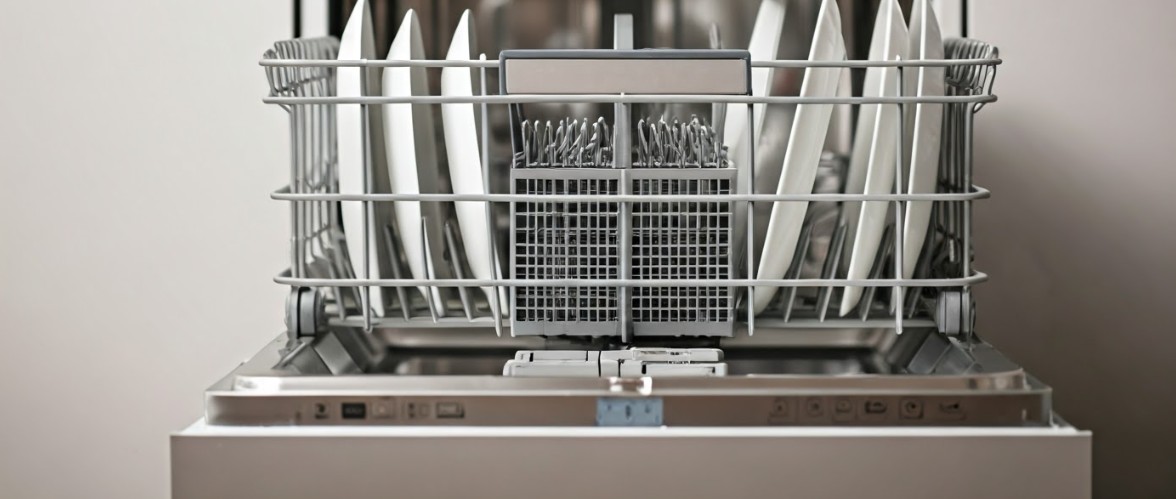A dishwasher is a key appliance in many homes. It makes our lives easier and saves us time. However, a cloudy interior can be annoying. This cloudiness often comes from mineral deposits from hard water, leftover food, or detergent residue. This buildup not only looks bad, but it can also hurt the dishwasher’s cleaning performance. This guide will provide you with simple and effective steps to tackle your dishwasher that has a cloudy interior. Let’s get started!
The Common Culprits Behind the Cloudiness
The main reason for a cloudy dishwasher interior is hard water. Hard water has a lot of minerals, mainly calcium and magnesium. During the wash cycle, when this water dries up, it leaves these minerals behind. This causes a white, chalky layer to form on the inside surfaces of the dishwasher. You can often see this buildup on the walls, spray arms, and on your dishes.
Besides hard water, food particles and detergent leftovers also add to cloudiness. If food particles are not rinsed off properly before you load the dishes, they can stick inside the dishwasher and harden over time. Using too much detergent can cause a soapy residue to build up, which can also make the dishwasher look cloudy.
The Step-by-Step Guide to a Sparkling Dishwasher
A cloudy dishwasher can be really frustrating. Luckily, you can bring back your KitchenAid dishwasher or other brand shine with just a few easy steps. The most important thing is to find out what is causing the cloudiness and use the right cleaning method.
The next part will walk you through simple steps to clear the cloudiness and keep your dishwasher sparkling. You will discover both homemade solutions and store-bought cleaners to handle this common issue.
1. Identify the cause of the cloudiness
Before cleaning your dishwasher, identify the cause of cloudiness: hard water, food residue, or excess detergent. Different causes require specific cleaning methods for optimal results. White, chalky spots indicate hard water deposits, while greasy or sticky cloudiness suggests leftover food or detergent. Understanding the issue helps determine the most effective cleaning approach, whether it’s using a vinegar solution for hard water or deep cleaning the filter for food debris.
2. Clean the dishwasher interior with vinegar and baking soda
To clean a cloudy dishwasher interior naturally, use vinegar and baking soda. Vinegar removes deposits, while baking soda scrubs. Here’s how:
- Put vinegar on the top rack
- Run a hot cycle
- Add baking soda
- Run another cycle for freshness
3. Use a commercial dishwasher cleaner or descaler
Homemade remedies and store-bought cleaners are both effective in clearing a cloudy dishwasher interior. These products target mineral deposits, soap residue, and grime that cause cloudiness. When selecting a cleaner, opt for one designed for dishwashers to ensure compatibility. Follow the manufacturer’s guidelines for optimal outcomes. Typically, these cleaners are available in pre-measured tablets or liquid form for convenience. Remember to run a cleaning cycle without dishes to allow the cleaner to work effectively, resulting in a sparkling dishwasher.
4. Check and clean the dishwasher filter
The dishwasher filter is crucial. It prevents food bits from clogging the dishwasher and causing cloudiness. Food, grease, and debris can accumulate over time in the filter. This buildup reduces its efficiency and may result in cloudy stains inside the dishwasher. To maintain a well-functioning dishwasher and prevent cloudiness, clean the filter regularly. Most dishwashers have a removable filter at the bottom. Consult your dishwasher manual for specific instructions on locating and removing the filter. Once removed, rinse the filter thoroughly under running water to remove loose particles. For stubborn grime, gently scrub with a soft brush or sponge. A clean filter ensures optimal dishwasher performance and helps avoid cloudiness in the future.
5. Run a hot water cycle with lemon juice or citric acid
To remove cloudiness and smells in your dishwasher naturally, try lemon juice or citric acid. Lemons’ acidity can dissolve mineral deposits, leaving your dishwasher sparkling. Just pour half a cup of lemon juice or two tablespoons of citric acid into the bottom of your empty dishwasher. Run a hot water cycle to clear any buildup and create a fresh lemon scent. This eco-friendly method keeps your dishwasher clean without harsh chemicals, maintaining freshness and cleanliness effectively.
6. Wipe down the interior with a damp cloth
After you clean, wipe the inside of the dishwasher. Use a damp cloth to wipe walls, door, and edges. Check areas where dirt accumulates, like around spray arms and detergent slot. Wring out the cloth well to prevent streaks. This final wipe will make your dishwasher interior shine.
Conclusion
In conclusion, keeping the inside of your dishwasher clean and shiny is very important for good cleaning. You should find out what causes your dishwasher has a cloudy interior and follow a simple cleaning guide. You can use items from your home or buy cleaners to help you. Regular cleaning helps stop residues and limescale from building up, which helps your appliance last longer. For more tips, check out our blog on Causes & Cleaning Tips for Dishwashers That Smells Bad.
Frequently Asked Questions
Can I use regular household vinegar for cleaning?
Yes, regular white vinegar can be used to clean your dishwasher. It works well in breaking down mineral buildup and taking away smells. For the best results, use it in a hot water cycle.
How often should I clean the dishwasher to prevent cloudiness?
You should clean your dishwasher at least once a month. This helps to stop cloudiness. If you live in a place with hard water or wash many dirty dishes often, you might need to clean it more.
What is the white film on the inside of my dishwasher?
The white film you notice inside your dishwasher is probably mineral buildup from hard water. It can also come from soap residue or leftover food bits. Regular cleaning can help get rid of this film and stop it from coming back.

